Serendip is an independent site partnering with faculty at multiple colleges and universities around the world. Happy exploring!
Bio 202, spring 2008 - notes

|
The challenge in general
- Sightless Parent Fish Don't Produce Just Sightless Hybrids
- Possible Link between Sleep and Risk for Diabetes
- A Stable Life, Despite Persistent Dizziness
- Living in Fear and Paying a High Cost in Heart Risk
- Antidepressant Studies Unpublished
- Monkey's Thoughts Propel Robot, a Step That May Help Humans
- Training the Multitasking Brain
- Genetic Flaw May Explain Some Cases of Autism (see also Autism Gene Findings Raise Questions, Hype)
"The more scientists look, the more they're able to tease romance apart into its individual strands--the visual, auditory, olfactory, tactile, neurochemical processes that make it possible."
Jeffrey Kluger, "Why We Love", Time Magazine, 17 January, 2008
"Moral intuitions ... are being explained with tools from game theory, neuroscience, and evolutionary biology"Steven Pinker, "The Moral Instinct", NYTimes Magazine, 13 January 2008
"if time doesn't exist, why do we experience it so relentlessly? Is it all an illusion?"The response in general
Assemble a team of people with different backgrounds/perspectives to look into what is emerging from scientific exploration, become familiar with it and its implications, become involved directly and/or by helping others understand/become involved
Who are we? (details in "Getting Started" in course on-line forum)
| Biology major? | 20 |
| Psychology major? | 22 |
| NBS concentrator? | 6 |
| Other majors | English, Art History Philosophy,Anthropology, French, Math, Theater, German, PolSci, Economics, History, Sociology, Postbacc |
| Satisfy science requirement | 2 |
| Interested in biology/nervous system? | 20 |
| Interested in psychology/behavior? | 14 |
| Interested in philosophy/nature of reality/human experience? | 18 |
| Interested in practical problems? medicine, psychiatry, education social activism, etc? | 18 |
| Want to understand who you are? why you/other people behave the way you/they do? What you/they can do about it? | 10 |
The challenge more specifically
Neurobiology and BEHAVIOR ... what is "behavior"?
| Everything we can observe another organism/person doing from outside them, together with everthing we think we need to imagine going on inside them to account for what we observe from outside (emotions, drives, creativity, consciousness, agency, rationality, self?) |
NEUROBIOLOGY and behavior ... Neurobiology = study of the nervous system ... what is the "nervous system"?
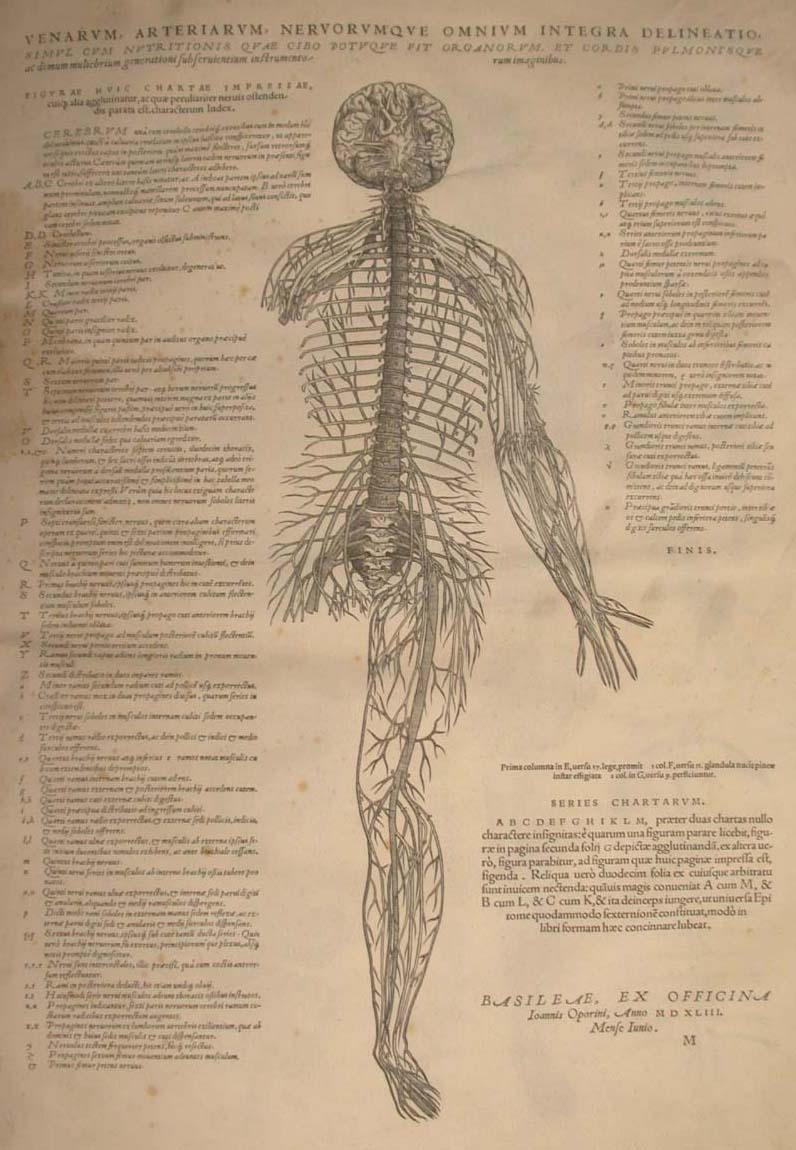
|
Image by Andreas Vesalius (1514-1564), contemporary of Copernicus, suggested (less than 500 years ago) that nervous system rather than heart was origin of behavior (see Milestones in Neuroscience Research for a time line extending from 4,000 B.C.). | 
|
Image by Rene Descartes (1596-1650). Set framework for several centuries (and continuing) discussion: mind and body distinct things or same thing? |
| Nervous system is material object, part of body, can be touched, manipulated, measured. What IS the relationship between brain (nervous system) and behavior (broadly defined to include human experience)? Subset of this are questions such as the relation between mind and brain, mind and body, matter and spirit, matter and form ... | |||
The core of the challenge
- Emily Dickinson (1830-1886)
- Francis Crick, 1995: The Astonishing Hypothesis: "a person's mental activities are entirely due to the behavior of nerve cells ... and the atoms, ions, and molecules that make them up and influence them".
- V.S.Ramachandran, 2003: " it never ceases to amaze me that all the richness of our mental life - all our feelings, our emotions, our thoughts, our ambitions, our love life, our religious sentiments and even what each of us regards as his own intimate private self - is simply the activity of these little specks of jelly in your head, in your brain. There is nothing else"
- Paul Grobstein, contemporary: "Brain = behavior, there isn't anything else."
- Descartes (among others) was ... wrong? We are actually nothing more, and nothing less, than organized clumps of matter? From which it follows that ... ?
Brain = behavior?, from a "scientific" approach:
The Nature of Science
Science as Story Telling and Story Revision
(article, web resources, on-line forum)
| Linear science | Seriously loopy science |
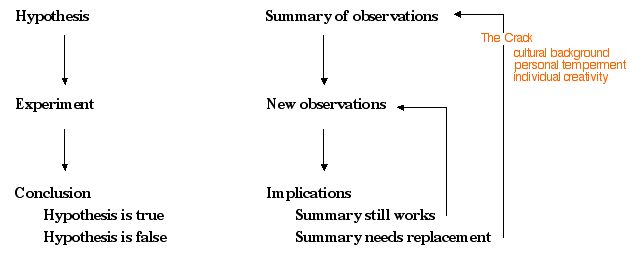
|
|
| Science as body of facts established by specialized fact-generating people and process
Science as successive approximations to Truth
|
Science as ongoing process of getting it less wrong, potentially usable by and contributed to by everyone
Science as ongoing making of observations, intepreting/summarizing, making new observations, making new summaries Science as process of inquiry into anything, one which everybody is equiped to do/can get better at/be further empowered by, and contribute to - a way of making sense of what is but even more of exploring what might yet be |
| If science is as much about creation as discovery then the "crack"is a feature, not a bug ... and differences among people are an asset to the process rather than a problem or an indication it isn't working |
Trying It Out
Which of the following two stories do you prefer?- The earth is flat (Flat Earth Society)
- The earth is round
Because of ...
- personal observations?
- observations made by others (personally verified or not)?
- social stories (heard from others)?
- usefulness?
Is one or the other story true? Have there been others? Are there others? Will there be?
Which of the following two stories do you prefer?
Because of ...
- personal observations?
- observations made by others (personally verified or not)?
- social stories (heard from others)?
- usefulness?
- is one or the other story "true"? are there others?
Is one or the other story true? Have their been others? Are there others? Will there be?
Scientific stories are
frequently efforts to summarize the widest possible range of
observations, always motivate new observations and hence new stories,
should never be understood as "authoritative" or "believed in", do not
compete with or invalidate other stories.
Key issues about scientific stories
|
Which story do you prefer about brain and behavior?
| Descartes et al: There is brain and mind (or soul or ...) | 7 |
| Dickinson et al: Its all brain/neurons/matter ... | 18 |
| Unsure/fence-sitting/other |
13 |
Issue is not "Truth" but whether there is a good "summary of observations", "working hypothesis", something that contributes to getting it continually "less wrong" is useful for the ongoing generation of new stories in science and in culture at large ... Keep "loopiness" in mind, not only for science but also for the brain
Start with overview of the "trend of the evidence": [skipped over this year, to return to?]
- Behavior can be altered by altering the nervous system
- Traumatic brain damage
- Surgery, drugs, and ... ?
- Epilepsy as an instance
- Lots of aspects have behavior, even quite sophisticated ones, have "material" feel about them
- Surprising and quite sophisticated things can emerge from interactions of simple elements (of which the brain/nervous system is an example, as we'll see).
- It isn't that anything "disappears" as one discovers things related to
the brain but rather that the Brain gets "wider"
- Disadvantages?
- Advantages:
- ???
- would make the unobservable observable?
- Brain=behavior "True"? ("perhaps we just do not have the right microscopes yet"?). Good "story"?
Our task for the semester (and beyond?):
to try and make sense of an existing and continuing explosion of observations on the brain, observations that have the potential to greatly influence our sense of ourselves and our relation to the world .... and to help others make sense of it as well.
Your starting thoughts about "brain=behavior", about science as story? ... are they good summary of observations? stories? What observations do they not incorporate? What new questions do they raise?
From the Forum
Too often science has been thought of delivering a truth tantamount to that of a religion ... science itself calls for the scientist to consider herself/himself and her/his role within science as a body ... The scientist should be aware that she/he is first and foremost a human, not the objective all seeing eye that the public often regards her/him as. The scientist needs to consider her/his position not only within her/his phylogenetic history, but her/his ontogenetic history as well ... Jessica Krueger
As much as I like the idea of commending being wrong, I don't think we should value it over being right. Just because we may never find "truth", we shouldn't lose sight of the fact that our goal is to get as close as possible, and, in order to do that, need to get some things right ... Emily Alspector
if science doesn’t provide a sort of truth, how can it really be justified using in public policy? ... Anna G.
See Getting It Less Wrong and Science as Story Telling and Story Revising and The Empirical Non-Foundationalist and the Phenomenologue; is relevant not only to science but to brain, as we'll see
I have been found guilty of believing what scientists around me consider to be the "truth." Never have I asked to see a summary of their observations! ... Margaux
In class today, we were perhaps too quick to accept Crick’s theory. Where were the observations? Were we more accepting of this position because we rely so heavily on drugs? Because we see great distances between spirituality and scientific “reality?” ... EB Ver Hoeve
| Decartes et al Pros and Cons |
Dickinson et al Pros and Cons |
|
I have always thought of the mind as being a separate entity from the body, though the body includes the brain. Both function together to motivate, drive, and create behavior bidirectionally. Somatic symptomatology can be caused by psychological problems and vice versa ... many of us may experience a cold or other sickness resulting from a lowered immune system, which is caused by elevated stress levels. On the other side of the same coin, genetic predisposition can affect one's likelihood of manifesting a psychological disorder, such as depression. Examples such as these lead me to support Descartes position on mind-body dualism ... lcarbonello
conscious effort of the mind can alter the physical reality of our bodies ... Jen Benson most physical events – like, say, knocking something over – don’t result in [mind, consciousness]. A binder knocked off of a desk (presumably) doesn’t have any awareness of hitting the floor. So why doesn’t light simply enter the eyes, travel to the brain, go through all kinds of complex processing, and emerge as behavior, without there being any experience, awareness, or consciousness accompanying these events? ... Caroline Feldman implies to me that humans are mere machines, complex machines, but still ultimately without agency ... Julianne Rieders if we believe brain=behavior then that also means that moral judgment, and thoughts are all caused by physical factors. I don't understand how these abstract concepts can be explained through physical matter ... Penn Tong I had more of a leaning towards Crick and Dickinson, but what you said made me think ... if behavior was completely biologically based (if it was all attributed to the brain), then all behavior would be for a reward. Hence, it is confusing to me why we exhibit altruism - it has no purpose in terms of survival ... Perhaps altruism (and moral judgment as Penn said) are behaviors that are constructed by the mind/soul ... Paul Bloch The brain if it had its way all the time would most likely make sure that as individuals that we lived more sheltered lives. Our behavior has got to be influenced by more things, and the brain is just one of them ... Tara Raju I found it kind of disconcerting to think in Dickinson's terms that everything we see is only constructions of the brain and nothing more ... Kendra there are people that do have the same experiences or have the same backgrounds and/or cultures who still are very different from one another. How is this possible? I believe this is because of the existence of the mind. This is how we are so unique ... rdelacruz If the brain were responsible for constructing everything in the world, how then would we account for objects that most people perceive in the same manner? ... greta flaherty I am a person, who you might have guessed, is intrigued by the paranormal and supernatural elements of life and who finds that the existence of an "other" experience of reality, time, etc. somehow necessary for my existence i.e. I want to believe/believe in this phenomenon ... mcrepeau |
unless we claim to have a different ancestry than evolution describes, I don’t see how a nebulous mind could exist (or even, using the principle of parsimony, why it would have to) when we developed from a shared ancestor with creatures most claim do not have minds ... Anna G.
clinical depression, schizophrenia, bipolar disorder and post-traumatic stress disorder are brain diseases that impact personality and other mental functions ... mkhilji Kedia et al. provided interesting observations that linked emotion with the brain. Using fMRI technique, they observed a change in brain activity in the prefrontal cortex after the subject was emotionally stimulated ... Paul Bloch It is only very recently that some of the mysteries of the brain have been unraveled ... Techniques, such as fMRI (http://www.radiologyinfo.org/en/info.cfm?pg=fmribrain&bhcp=1) have elucidated particular regions of the brain and their functions. These observations do not unto themselves answer the question of whether the mind lies within the brain, along with the "spirit," but they encapsulate one layer of observations that are quite compelling ... Sophie F. maybe both nature and nurture are internalized through the brain ... Marie Sager Reacting to stimuli in a purely physical way is one thing, but being fully aware of what is happening around us, and having opinions, etc…is another ... I think that my views can be summed up most accurately in the idea that the “mind” or “consciousness” is an emergent property of the nervous system ... all of the nerve impulses, and received signals, and physical and chemical responses can combine to produce a thought in the individual, which then becomes a part of that individual’s knowledge. Since all individuals other than identical twins have some genetic differences, and since no two individuals can have the exact same set of experiences ... all people could then be expected to have unique collections of thoughts, opinions, and reactions/behavior to different situations ... Caitlin Jeschke "I said in Dorian Gray that the great sins of the world take place in the brain: but it is in the brain that everything takes place.... It is in the brain that the poppy is red, that the apple is odorous, that the skylark sings." ~Oscar Wilde ... meredith2e The conclusion made in class was basically that each individual brain interacted with the world on its own, which means therefore that each individual has its own construct of what the world is ... With as many differences as each individual possess, it’s hard to imagine that with every person having individual set of experiences and observations that there is a common description capable of including and meeting everyone's version of specific objects or places, let alone the whole world ... cheffernan can we not also argue that the brain itself is a construction of the brain? ... Jackie Marano |
|
|
IF Emily et al are right:
- "brain"="nervous system"=body=matter, therefore all action/experience a function of organized matter? complexity from simplicity?
- Brains must not be only "reactive"
- Brains are to some degree different in different people
- Brains in given people must change with time/experience, must be affected by culture/language, nexus point for ALL influences on behavior?
- Brains must have different parts?
Some starting points: a sphagetti bowl? ("chains of neurons" or "hormones, chemicals")
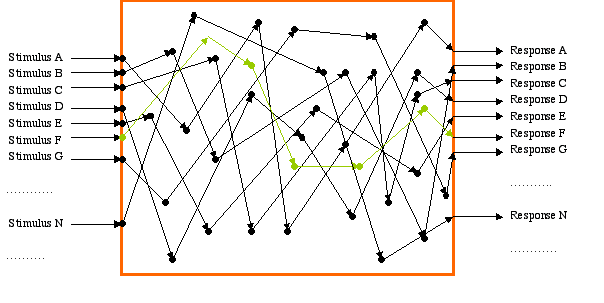
|
The sphaghetti (switchboard, "reflex") box
model
Virtues
|
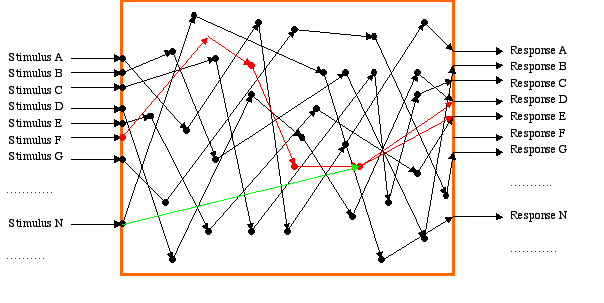
|
Sphaghetti (switchboard, "reflex") plus box
model
Virtues
|
A rethinking - boxes in boxes
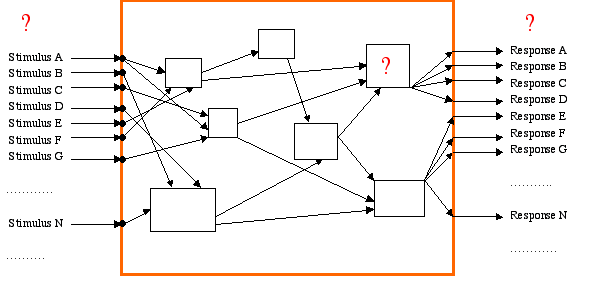
|
The sphaghetti (switchboard, "reflex") box
model
Virtues
|
Facing up to the stereotopy, stimulus-response problem ... freeing the box from the outside world, adding autonomy
| Harvard Law of Animal Behavior
"Under carefully controlled experimental circumstances, an animal will behave as it damned well pleases"
|
The boxes inside boxes (with
"autonomy") model
Virtues
|
If brain=behavior then the nervous system must not be a stimulus/response machine (nor a bag of chemicals) that is invariant and the same in everyone. It must instead be a different kind of "system" (Emily Alspector)
- somewhat different in different individuals,
- affected by both genes and experiences/culture,
- capable of
- different outputs for the same input
- taking in inputs with no output
- generating outputs with no input
- a "semi-autonomous" input/output box consisting of input/output boxes.
Go on to look at actual nervous systems to see if they satisfy expectations and to
address issues ... further iterations ("getting it less wrong") to come (duality? (Emily Ambash), linearity (Michelle Khilji)?)
The "real" nervous system - an input/output box consisting of interconnected input/output boxes?
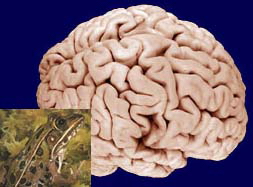
|

|
| photo from Kemali and Braitenberg, Atlas of the Frog Brain, Springer-Verlag, 1969 |
Each box in turn (somewhat arbitrarily) subdividable into smaller boxes (with some differences among vertebrates, to return to)
And those ... yes, "its boxes all the way down"
The smallest box: neurons everywhere
Invertebrate nervous systems also have neurons, but differently arranged - makes sense?
Neuron as common, smallest box and as input/output element, connected to other boxes
- Cells, like other cells, but specialized to receive/process transmit "information" (as opposed to matter or energy)
- Size scale - tens of microns (10-6) meters)
- Larger boxes must differ in how smallest interconnected
- Relevance of numbers? enough to "account for all the uniqueness that exists among people"? ... 1012exp1012 possible nervous systems?
- Differences between people, differences between organisms due to .... not building blocks but assembly (architecture)
- Need to know how neurons work - to return to
Can use boxes->boxes ... ->boxes(neurons) to show that larger boxes interconnected, in relatively specific ways (anatomical specificity) and to rigorously specify "input" and "outputs" of largest box ... nervous system itself
- grey matter (soma, dendrites, pre-synaptic terminals, neuropil) vs white matter (bundles of axons, tracts)
- central vs peripheral nervous system (some ganglia, but largely axon bundles
- output elements of nervous system (motoneurons, plus) = neurons with axon terminating outside nervous system
- input elements of nervous system (sensory neurons, plus) = neurons with receiving surface (dendrites) outside of nervous system
- everything else = interneurons
- numbers/proportions: more reason to think of ns as "semi-autonomous"
So ... at least parts of our box within box model real ...
Your thoughts about the brain as a semi-autonomous nested set of input/ouput boxes?
The input/output boxes inside input/output boxes with autonomy - a good story?
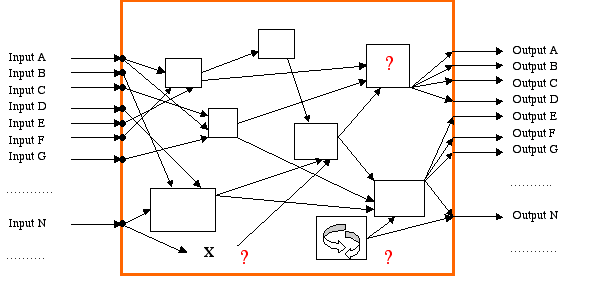
In general ...
Because of the previous connotations presented by words such as stimulus and response, it seems to me that the terms input/output are better used to describe the way the brain acts and links to the behavioral result of inputs ... Mahvish Qureshi
I believe that separating the external inputs from the internal inputs is worthwhile not only because it seems like an important distinction but also because it might allow our conversation to expand ... EB Ver Hoeve
and lots of others
Autonomy and randomness
is there really a such thing as having NO input...and JUST an output? I have always firmly believed that everything happens for a reason, but as humans we lack the ability to consistently identify the reason ... Jackie Marano
Are not "random" and "without reason" terms we, mere mortals, ascribe to that which we cannot understand? ... Sophie F.
when it comes to an entity like our nervous system, I would argue that nothing is random, and that every action that occurs within it is the outcome of another action, from either within or without itself ... Emily Alspector
one of the basic tenants of the behavior of an organism is that it
be predictable ... Jessica Krueger
My summaries of observations are in direct conflict with the idea that behavior is anything but predicatable ... anne.kauth
Some relevant added observations (see also Variability in Brain Function and Behavior and Indeterminacy in Brain and Behavior)
If everything were random, based ONLY on inclinations or thoughts or morals, I'm not sure how anyone could function in the world. On the other hand, if we could sum up the brain in simple, well-established, extremely logical stimuli/response categories, well, why would we even need to study it? I think the brain is somewhere in between ... the fact that females do not always respond predictably (or at all!) to males' chirps means that uncertainty, randomness, and agency are all a PART of the system ... eambash
The idea of input "dying" in the brain doesn't seem to be 100% accurate to me ... Anna G.
Suppose that consciousness exists in the brain ... why is it that some neurons cause consciousness to appear, while the others are merely pattern recognizers? What is it that decides what I am about to say next? ... Caroline Feldman
there definitely seem to be some inputs that are much more likely to generate thought (and therefore “awareness”) than others. The “conscious”/”unconscious” dichotomy persists ... Caitlin Jeschke
Other problems? directions to get less wrong?
Due to so many different combinations, you would think there would be easily an error in the brain's process or a backfire that would disrupt the visible trends completely, however, yet still, the brain triggers relatively accurate responses to different inputs ... jchung
What about schizophrenia? Is this a system mistake? ... Zoe Fuller-Young
it makes the brain seem linear ... mkhilji
The current system that we are commenting on is a stagnant system ... how were the boxes established? How were the connections between these boxes established? And how do you create more boxes and more connections? ... cheffernan
Can use boxes->boxes ... ->boxes(neurons) to show that larger boxes interconnected, in relatively specific ways (anatomical specificity) and to rigorously specify "input" and "outputs" of largest box ... nervous system itself
- grey matter (soma, dendrites, pre-synaptic terminals, neuropil) vs white matter (bundles of axons, tracts)
- central vs peripheral nervous system (some ganglia, but largely axon bundles
- output elements of nervous system (motoneurons, plus) = neurons with axon terminating outside nervous system
- input elements of nervous system (sensory neurons, plus) = neurons with receiving surface (dendrites) outside of nervous system
- everything else = interneurons
- numbers/proportions: more reason to think of ns as "semi-autonomous"
So ... at least parts of our box within box model real ...
Invertebrate nervous systems similar with different arrangements
The "real" nervous system - different if behavior different?
- Among different kinds of organisms?
- Among different individuals? within individuals over time?
- Notice that differences leave open the question of what causes differences (genes, experiences, activity, culture, etc)
- Implies that "information" can alter matter; not mysterious, "info" turns out to be perturbations of matter organization in neurons, can via metabolic processes influence organization/properties of neurons
Outputs - topographic organization - anatomical specificity
- Motoneurons located at levels of neuraxis related to location of muscles controlled
- Each motoneuron activates only one muscle
- Implications:
- "action" is not one output but pattern of activity across lots of them - "motor symphony"
- source of lots of additional variation in behavior
- lots of outputs/nervous system involved in any "action", is "distributed" characteristic
- need to understand how patterns of activity created, parts coordinated
- Sensory neurons terminate at levels of neuraxis related to location of receptors
- Implications
- "sensation"/"perception" not one input but pattern of activity across lots of them (across modalities and, as will be seen, in one modality - another "distributed" characteristic
- need to understand how inputs combined
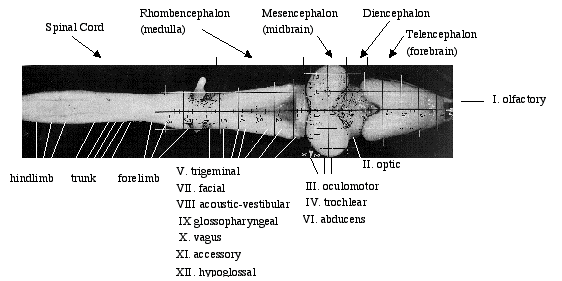
|
For additional information: |
Usefulness of the interconnected box model and ... another box?
- Capabilities of spinal cord
- Quadriplegia (slightly better) - relevance of topographic organization
- Christopher Reeves and ... , from NIH
- The "I-function"
Observations "surprising", but have to be accepted - Issue is "how to make sense of them"
Two kinds of behavior ("reflex" versus something-else) intuition probably not useful
- Spinal cord capable of very sophisticated activity
- Brain capable of quite unsophisticated activity
- Distinction between "reflex" and other things?
- "foot withdraws when irritated" - spinal cord capable of
sophisticated activity on own
- is ok ... given topography and "physical contiguity principle ("PCP")
- "person doesn't say ouch when foot irritated" - behavior frequently
depends on linking paths within nervous system
- is ok ... given topography and "physical contiguity principle ("PCP")
- "person doesn't move foot when hearing (or reading) request to do so" -
behavior frequently depends on linking paths within nervous system
- is ok ... given topography and "physical contiguity principle ("PCP")
- "person says foot irritation not felt/experienced" - behavior frequently
depends on linking paths within nervous system
- is ok ... given topography and "physical contiguity principle ("PCP") AND ..
- "behavior" can occur without it being experienced by the behaving organism AND ...
- neuronal circuitry adequate to support "feeling/experiencing" (I-function) is in the brain (spinal cord not needed for this function)
- Where is Christopher Reeves? Is he paralyzed? Does he feel pain? -
has to do with "mind", "self", "soul", "personality", "consciousness" ?
- words requiring redefinition in light of new experiences/observations?
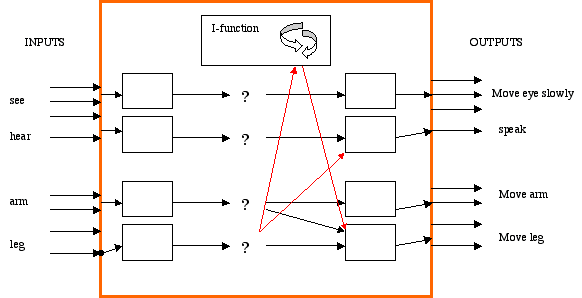
|
Ascending somatosensory
pathways Descending motor pathways
|
Your thoughts about "I-function", etc?

Neocortex and mammals
"higher functions such as sensory perception, generation of motor commands, spatial reasoning, conscious thought and in humans, language" ... Wikipedia
I can't help but think that such definitions come out of our own arrogance and necessity to validate our "inherent superiority" as mammals, and furthermore as humans ... I'm really curious to know how all the aforementioned parameters were measured ... nasabere
more sophisticated communication? ... Lyndsey C.
parental investment in mammals/birds? .... Molly Pieri
complex societies ... Jen Benson
Metacognition, theory of mind ... Simone et al.
Awareness of the self seems to me like something humans may possess more of than other animals, even though others clearly have some level of it too ... eambash
I definitely agree that we should not dismiss the possibility that other species (especially other primates or mammals, and dolphins) have the capacity to have an I-function in their nervous systems, since we can never know their subjective experiences ... Jen Benson
"Man had always assumed that he was more intelligent than dolphins because he had achieved so much... the wheel, New York, wars, and so on, whilst all the dolphins had ever done was muck about in the water having a good time. But conversely the dolphins believed themselves to be more intelligent than man for precisely the same reasons." ... Douglas Adams, via K.Smythe
there is a you that exists in your own "mind", your own sense of "I-function", and there is also a "you" that exists in the minds, perceptions, the part of the brain that builds a representation of you, etc. of others, and each one is a little different, a little unique unto itself, and it is a you that, ironically, you may never know or understand or even be aware of ... mcrepeau
The I-function
I think the "smooth eye" experiment we did in class on Thursday was REALLY cool. The idea that we are only A PART of our nervous system both intrigues me and freaks me out. I feel like there is some kind of alien/machine inside of me...and I've always thought that everything in my body/everything my body did and achieved was ME, but this experiment raises new doubts and avenues for exploration ... Marie Sager
I tried to find evidence of other ways in which we can see how the "I-function" is, in fact, just a piece of the nervous system ... sleep paralysis? .... Jackie Marano
hypnosis? driving? ... rdelacruz
neocortex has something to do with dreaming or perhaps I-function awareness? ... Emily Alspector
did we assign a location of the I-function within the brain? ... what happens to people who are in a coma. what happens to the I-function? ... animals lack an i-function, right? but what makes them aware of their separateness from others if they don't even cognize that they possess a self? and what about domesticated animals who's sensitivity to others seems to be heightened? how can they do this without an i-function? ... Lyndsey
While, for example, my dog knows when he has committed a crime in our household, I am fairly sure he does not spend his days wondering why certain rules have been set in place or even the legitimacy of the institution which has created those rules ... Angel Desai
the “I-function” is seen as the “all-mighty” box, capable of integrating the patterns of signals that we receive from all of our sensory neurons, and sending out signals to our motor neurons to generate behavior. Some people in the forum have suggested that the “I-function” could be “the mind”. However, I think that such descriptions tend to overstate the importance of the “I” box in relation to the other parts of the nervous system ... Caitlin Jeschke
If the “self” is a box within the nervous system, the dualism of conscious and unconscious seem less murky. In schizophrenia, are there two (or more) boxes vying for the “I-Function”? ... ... Sophie F.
I think the problem with this "I-function" is that only the individual is able to know if it is still functioning or not. No one else is able to know if another person is aware if no action is produced to communicate that they are conscious ... redelacruz
and consciousness?
I would argue that even with the “I-function” it is still possible to be unaware or unconscious of certain things that we do or think. These are, after all, related to the unconsciousness that Sophie F reflects on ... ("if there is a dualism or co-existence between the conscious and unconscious, can they be at odds?") ... maggie_simon
I left class wondering if we are going to talk about definitions of consciousness in class this week ... Skye Harmony
Outputs without inputs? Inputs without outputs?
I am having a hard time grasping the concept of the nervous system in terms of interconnected boxes that can generate signals on their own ... Margaux Kearney
Don't any of the principles of causality apply to the brain- don't you need some sort of input to get an output? ... anne.kauth
when the NS produces an output on its own there is no input but there must still be a cause/reason...its just from within ... there needs to be some kind of control mechanism to the nervous system. Otherwise, we could be twitching whenever the NS felt like it ... Nelly Khaseleve
Look at people who have epilepsy. They have these uncontrollable spasms ... Penn Tong
how there can be an input with out a resulting output ... I think that such a thing can occur if the input does not generate enough of a stimulus to result in an action potential, that goes above a threshold value ... Mahvish Quereshi
it is quite possible for nervous system activity to go unnoticed by the person, or organism, in whom the signals are being transmitted ... Caitlin Jeschke
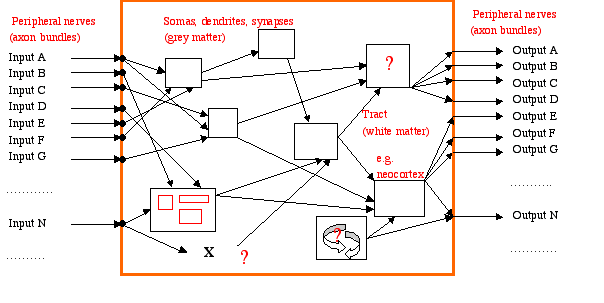 If its all sensory neurons, motoneurons, interneurons, and signals
moving among them (the I-function included), we need to look at signals, what they are, how
they're handled ...
If its all sensory neurons, motoneurons, interneurons, and signals
moving among them (the I-function included), we need to look at signals, what they are, how
they're handled ...
Signals:
- Resting potential
- Action potential
- Receptor and generator potentials
- Synaptic potentials
Start with action potential, use it to raise questions that will lead to explanation of resting potential, use those ideas in turn to successively build up a set of more basic ideas that collectively account for all signalling.
- continual motion (diffusion)
- concentration gradients of charged particles (ions)
- specific membrane permeability
- passive current flow
- variable membrane permeability
Action potential - longitudinal battery which appears/disappears successively at successive points along an axon ("travels" at finite speed), "all or nothing" transient (millisecond range) event
- Helps to account for "thinking takes time"
- Is the common currency of "information" in nervous system cables (axons, axon bundles), of
all organisms
- Problem: how distinguish action from perception from thought?
- Solution: anatomical specificity ("see thunder, hear lightning")
- Is way to "see" otherwise unobservable
- Need to understand it - doing so will help make sense of other potentials, provide further insights into how ns COULD be behavior
To understand action potential, need first to understand resting potential - transverse battery, continuously present, with potential for continuous variation
| Organization based on random motion |
- Diffusion
- Selective permeability
- Charged particle movement, balance of diffusion and battery creation
- Stable
transverse battery, with potential for variation
- Concentration gradients, energy dependent ion pumping
- Can get action potential? what more?
Propagation
Notice it is NOT matter moving, nor energy, it is a perturbation (signal, information) |
Will propagate if started. How affect things? How started? Need to understand synaptic potentials, receptor potentials, but first ...
Lots of things can start it. Among them is something that provides answer to one of our box questions ...

And the big question ... Do signals actually start in the middle of the box? If so, how?
Yes, not mysterious, follows from what we know, if we add possibility of some differences in permeability of some membrane regions not mysterious, has interesting implications ...
- brain in a vat
- action without "personal responsibility"?
- epilepsy
- other things?
Go on to receptor potentials, synaptic potentials (how action potentials affect things, how boxes integrate, how signals stopped in box)
Input (sensory) signals - an example
- Neuronal receiving surface outside nervous system
- Sensory transduction - specific channels varying permeability in response to external events
- Receptor potential - continuously variable in space/time (like passive current flow
- Transformed into action potentials
- Coding in pattern of action potentials
- Significance for behavior?
- Restricted sample of "reality"
- All representations of "reality" in same form, in same signals as those created in nervous system itself
- Anatomical specificity IMPORTANT ("hear lightning, see thunder")
Lightning and thunder
If the action potential that propogates when you hear something is the same as when you hear something, does that really means that we potentially could move the extension from the auditory to the visual "box"? And are our Nervous Systems really like switch boards that propogate input manually because the signals aren't created uniquely for specific functions? ... Anne.Kauth
Eyes and ears receive input in very different ways (sensing light v. vibrations), and so the patterns of input signals that are sent through the nervous system when we "see" lightening are not the same as the patterns that come from "hearing" thunder. And if one were to somehow "switch" the cables, so as to send visual signals to the auditory box, and auditory signals to the visual box, then I think that the perceived output would be quite different from the kinds of sights and sounds that we are used to...wouldn't they? Maybe these types of phenomena are similar to what happens to individuals with synesthesia? ... Caitlin Jeschke
Can the idea of proper wiring, that is the correct connection of input and output boxes when all of the action potentials throughout the body are the same, explain some disorders such as dyslexia, where the input results in a different output from those who suffer from the disorder? ... Madina G.
a nod towards the brain's central role in the construction of sensation? ... Jessica Krueger
"Batteries" and action potentials revisited: observations, interpretations, implications
In class we discussed how an action potential is related to a battery. I found a site that compared it to an electrical wire “An 'action potential' is the name for an electrical message carried along the axon or dendrite of a neuron, like an electrical impulse carried along a wire. These tiny electrical signals would not be able to travel very far if the axons were not insulated" ... Caroline FeldmanThe analogy of the battery has mostly confused me ... Prof. Grobstein argues that we should not think of action potential in terms of electricity because electricity travels at a much higher speed than a signal through an action potential. However, I still find it helpful to combine the idea of a battery with electricity, as long as we recognize that an action potential is a slower process. This way, I can better imagine how the batteries go from one charge to another, and that activity remains during resting potential, much as electrical power is maintained even if the light bulb is not turned on ... I wonder how understanding Myelin, and Multiple Sclerosis as a disease of the Myelin, can help us understand action potential, and action potential as a battery/electrical pulse, and questions of speed? ... Zoe Fuller-Young
The battery analogy was not one of my favorites- for me, it just left to many questions unanswered I stumbled upon a website (www.mult-sclerosis.org/actionpotential.html) that discusses this topic. It says: "An often used but slightly misleading analogy for how nuerons work is to compare them to electrical wires along which nerve transmissions flow. THis is not actually how they work. A better analogy is to imagine a skipping rope lying on the group. If you take hold of one end of the rope adn give it a quick vertical flick, a wave will move along the rope away from your hand. Nothing except energy actually moves down the rope and, whtn the wave has finished, the rope is in the same position it was before you sent the energy along it". To me, this jump roping analogy is more along the lines of what I imagined the nueron transmission actually occured. I have always thought it was a quick impulse and then the activity returned to its original state ... For the myelin sheath, I tend to think of this has a wire casing. On thick wires, like our internet cords, the rubber that holds them all together is what I tend to think of the myelin sheath. It holds the impulse together and contains materials that foster the ability to send the impulse quickly and without it, the message could be lost along the way ... Tara Raju
I think the main reason that I have had difficulty thinking of action potentials as batteries is because the concept of the "battery" itself connotes a physical object that resides somewhere "within" the nervous system. The action potential as it exists however, is not technically an actual object which can be picked up the same way a battery can ... Is there a relationship between the action potentials on the molecular level, and experience in the psychological or material sense? ... Angel Desai
Our neurons are firing and creating a whole world for us. That is why I dislike the analogy of action potentials as a battery. To place those two things side by side makes us think that neurons are nothing more then a wire and the action potentials as nothing but electricity running through it ... Isabelle Winer
I don't necessarily understand the need for the analogy, and am looking forward to seeing where this goes ... Anna G.I thoroughly enjoyed our class discussion thursday about action potentials and how they can be compared to batteries. I've only taken Intro Bio so far, so I only had the perception that action potentials were electrical impulses that traveled down an axon from one neuron to the next. I never even considered electricity traveling the speed of light, so i didn't know that this concept was incorrect with respect to action potentials. I didn't ask to observe any summaries of observations! ... Margaux Kearney
The explanation of Erwin Schrodinger's theory helped me understand diffusion a lot more. I have learned it before, but never really thought about it as much as we did in class. It cleared up some questions I had about depolarization and hyperpolarization ... I think it is interesting that molecules moving randomly can depolarize a membrane and produce action potentials allowing for actions when I actually do want to produce an action. This makes me wonder how these ions know when to depolarize at the right time when I want to move or feel. It is because they are constantly depolarizing and the reason I do not produce an action is due to the action potential not reaching a target neuron? Is there something coming from the nervous system telling the ions to depolarize or not? ... rdelacruz
I think that thinking of the nervous system and behavior with these new terms in our vocabulary it is a bit more plausible to explain the phenomenon of an input with out a visible output. If the signal does not generate a strong enough action potential then there will not be a stimulation throughout the nervous system to generate a response/output ... Mahvish Quereshi
While we certainly covered concentration gradients and the transfer of a message via electric actions between sodium and potassium ions in Intro Bio, we never related such a critical biological process to the function of a battery ... a major contributor to the validity of our battery model is, in my opinion, the fact that action potentials can still be produced/measured for some amount of time AFTER the system/organism has died ... Jackie Marano
I will admit that when we were discussing batteries and then turned the discussion to membrane permeability, I was thrown off and thought the two had very little to do with each other. Then, just as class was ending, everyone was neatly tied together and it really did help my understanding of action potentials in a way I had never thought of them before. I have taken Intro bio and other NBS-related courses, but I had never been given the opportunity to look at an action potential in such a relatable way ... Emily Alspector
In class we
have discussed how an action potential can be "passed" on from one
battery to another, but we have not yet discussed where the action potential
(the very first one in the line of propagation), in terms of the energy that it
is, comes from. What initiates the first action potential in an axon? ... where does this source
of energy come from? ... are we (since the catalysis for
these energy changes came from our parents) perpetuating an action potential of
some kind from our parents, from our ancestors?... mcrepeau
Extrapolating the idea of randomness from the microcosm of signal transduction to the effect of that random movement, namely outputs without inputs, for me begs a question: what sorts of outputs result from this random movement? Are they visible (to an observer) behavioral outputs? Are they autonomic processes of which we are not aware that mediate physiological processes? If no two brains are alike, and each brain capable of myriad cables connected to boxes, connected to other boxes… are some organisms more susceptible or likely to experience outputs without inputs? Is there some sort of “potential” energy stored that initiates the turning “on” of the battery? .... Sophie F
I'm so perplexed; my
confusion lies in the notion of zero input yielding outputs. It would seem that
an action potential, which ultimately yields some response, can only by
initiated by a depolarization in the axon membrane. Maybe I’m missing something major here, but
shouldn’t it follow that something—perhaps some input—must be present in order
to generate a change in membrane permeability, and thus a subsequent output? I
guess what I’m really asking is this; when, where, and how does the whole
process start if such a phenomenon as “zero input” exists? ... nasabere
- There IS a "battery" across the membrane, and it changes during an action potential - observations
- The signal, what is "moving" down an axon, is not electricity
- What is moving is also not "energy"; its a perturbation, a propagated change in batteries
The origins of batteries and of changes in batteries
- Diffusion, ie random movement of particles
- A concentration gradient of ions (charged particles)
- A semi-permeable membrane (one that allows some ions to cross it but not others)
- Membrane has "energy" stored across it, in the form of ionic concentration gradients created by an energy dependent pump
- Battery depends on permeability, can be altered by changing permeabiity.
- Battery is statistical, ie always fluctuating somewhat, for no reason other than the inherent randomness of particle movement
The action potential is, to a good first approximation, a propagated switch from relatively high potassium permeability to relatively high sodium permeability and back again
- Switches in permeability result from changes in protein shape, and hence take time.
- These changes in protein shape result from the fact that the proteins are themselves sensitive to electric fields.
- The less negative inside (the more "depolarized") the greater the sodium permeability relative to the potassium permeability.
- When the sodium permeability is much greater than the potasium permeability, a sodium battery is present, and conversely for a potassium battery.
Propagation of an action potential depends on passive current flow from a region with a sodium battery to one with a potassium battery
- An adjacent region will switch from potassium to sodium battery if current flow is large enough and sufficiently rapid so that it and increasing sodium inflow producesa large enough depolarization (positive feedback loop)
- If threshhold is not crossed, perturbation simply disappears (yes, one reason why signals can just end in the nervous system) - analogue to digital conversion, turns continuous fluctuation into signal/no signal
- Myelinated axons may conduct action potentials at greater velocity than non-myelinated ones because "insulation" enhances the effective distance of passive current flow
- An action potential started at a given point will propagate in all possible directions. Unidirectionality reflects a rudimentry "memory" in the nervous system: sodium inactivation. The difference between sensory and motor neurons, between input and output, is not inherent to the neuron but rather a function of its relation to other things (where action potentials start).
Passive current flow from a region with a resting high sodium permeability can cause adjacent membrane regions to spontaneously generate action potentials
- Signals CAN start in the middle of the nervous system irrespective of its inputs; signals can start in a neuron independent of its inputs
- Some degree of unpredictability is inherent in neuronal signal generation since it in turn reflects underlying statistical phenomena
Resting potential: a transmembrane potential (battery) that results from the combination of random movement of ions, ionic gradients, and selective membrane permeability
Action potential: an all or nothing change in the selective membrane permeability, and hence the transmembrane potential (battery), that propagates at a relatively slow speed down an axon because the passive current flow resulting from different transmembrane potentials (batteries) at neighboring locations exceeds a threshhold. Can initiate without input if there is some source of depolarizing current flow in the neuron itself ("leaky membrane")
Generator potentials, synaptic potentials yet to go (but make sense in terms of ionic gradients, permeability changes, passive current flow.

And further questions/issues
If one thing starts to change, does the process of change, or propagation of it, continue once it gets to the end of the axon? Does change in one battery, such as in one particular axonal membrane, necessarily lead to change in the next axon (the next neuron)? Also, if we're talking about an action potential as the process of changing to a separate battery and then back again, are we saying that there is always a default battery that the axon starts with? Would that default be the same for every battery? ... eambash
we have not yet discussed ion channels other than the "voltage-gated" type ...Caitlin Jeschke
Which sorts of outputs are a result of leaky membranes, and which are the result of non-leaky membranes? ... Jackie Marano
is the point of the battery model to remind us that we in fact are just a bag of chemicals and the notion of what was human was invented by the most powerful chemicals in the bag, those residing in our brains? ... llamprou
It feels as if we have abandoned what we discussed the first weeks of class ... cheffernan
I find myself forgetting what an action potential is doing. I've become lost in trying to understand the metaphor and have lost sight of the "bigger picture." Therefore, on the one hand the battery analogy has helped me understand an action potential, but my understanding of the system, that is our family of input output boxes, has not progressed ... Zoe Fuller-Young
the conclusion we came to at the end of class on Thursday concerning outputs without input finally makes sense to me. When we imagined this scenario a couple of weeks ago, I was on the side of those who believed that perhaps no input really is an input which would mean that its corresponding output was an output with an input ... Angel Desai
The topic that struck me the most fascinating dealt with leaky regions of the membrane. I explored this on the internet and found an article titled “Leaky Sodium Channel Makes Brain Prone to Seizures” ... Caroline Feldman
Like epilepsy, Tourette Syndrome is another interesting phenomenon that involves the random generation of outputs from the nervous system without any understandable input to the nervous system ... mcrepeau
My 3 year old cousin Katie was adopted and spent the first 5 months of her life in an orphanage in rural China. She was diagnosed with autism about six months after my uncle and aunt picked her up ... She had looked at the same walls and ceiling everyday, heard the same sounds and had the same physical contact with her caregivers ... though we concluded that an action potential can start and end in the middle of a nervous system, I am wondering how that much activity is possible when there have been so few inputs ... are these input-independent action potentials the reason why my cousin survived for her first five months? ... Anne.Kauth
if action potentials can start with no stimulus, then how do we still have controlled behavior – at least somewhat controlled? I just don’t get it… Leaky regions produce unpredictable action potential. However, i'd like to say we do have some predictable behavior ... Nelly Khaselev
I don't understand the significant/frequency of simple random depolarization without input that causes action potentials ... Purpose emerges out of this random movement and behavior, but…how? What are the intermediates that allow us to process random movement and utilize it so that we can act how we do? ... Ann G.
I'm still puzzled as to where "meaning" comes in to all this. To me, "meaning" implies volition, and I don't think our neurons are aware of the pulses and depolarization occurring, much less the motor response that is the eventual outcome ... Emily Alspector
In class on Tuesday, I was asked, as a dyslexic person "what does a page of text look like to you?" ... I might as well have answered Paul's question by asking "Well, what does a page of text look like to you?" ... Molly Pieri
it is our crime of subjectivity that prevents us from really knowing what it is like to be bat ... Nelly Khaselev
I think a possible explanation for why we label different colors is not due to vocabulary but to a slight difference in the way that our brains interpret the signal ... Jessica Varney
Our field tells us that consciousness, experinence, emotion, memory, everything is just "Salt running in and out of channels," as a friend put it the other day (also summarized by Francis Crick's The Astoninshing Hypothesis [among other things]). How, then, can we reconcile any idea of autonomy or agency ? How can we come up with such abstract ideas such as love? How can we conceive of anything happening outside the brain? ... Rebecca Woodruff
other classes tend to examine the initial interaction or the final reaction, but no one has dared to explain the complex processes in between ... with this class (a cross between the biology and the psychology), we have the time and we need to make the commitment to actually discuss the translation ... EB Ver Hoeve
Input (sensory) signals - an example
- Neuronal receiving surface outside nervous system
- Sensory transduction - specific channels varying permeability in response to external events
- Receptor potential - continuously variable in space/time (like passive current flow
- Transformed into action potentials
- Coding in pattern of action potentials
- Significance for behavior?
- Restricted sample of "reality"
- All representations of "reality" in same form, in same signals as those created in nervous system itself
- Anatomical specificity IMPORTANT ("hear lightning, see thunder")
- Extra-sensory perception
- "five senses"?
- proprioception (muscle spindles, tendon organs, plus)
- pheromones
- others?
Synaptic potentials - Synaptic integration
- action potential vanishes at synapse
- intermediate chemical step: neurotransmitter release and ... (multiple control steps)
- permeability change leads to synaptic potential, also continuously variable in space/time
- summation - neuron as integrator rather than relay
- inhibitory synaptic potentials, algebraic summation
- is how to "stop" signals - significance for behavior?
Receptor potentials, synaptic potentials/integration summarized (so far)
- inputs dependent on protein mediated permeability changes, analog to digitial conversion with threshhold
- neurons as individual "computers" rather than relays
- "thinking backwards" - chicken with head cut off
- other things, eg ...
epilepsy? tourettes? effects of alcohol and ... ? - "pharmacological" as well as "anatomical" specificity
Inputs: implications for behavior
I would like to revisit Dickinson's idea that the world is a manifestation of the brain; I feel like this point is truly driven home when looking at they how important various proteins are in our perceptions of the world. By having proteins in our eyes give the world colorful, having certain proteins in our ears makes the environment melodious ... cheffernan
Bees are able to see various patterns on flowers and a rattle snake can see in the dark because they possess something extra that humans do not have. This almost led me to actually believe in ESP. I have never been a fan of the supernatural world because it just seems too out there and unrealistic. However, what if there really are people who do possess a protein that allows them to sense things other people cannot? ... Rica Dela Cruz (see also Emily Alspector)
maybe many of the inexplicable diseases, happenings, etc. are all due to supernatural things that we lack senses to detect ... Jchung01
I think it's really value to remember that sensory systems reflect partially the environments that organisms have to live in and how they have evolved to most efficiently survive there ... Jen Benson
The reason that we cannot perceive infrared radiation or radio waves is because we do not have the proteins to detect them. However, we can perceive their existence through other apparatus that can detect them and that then translate them into stimuli that we can detect, such as the conversion of radio waves into sound waves. So in this sense, we can perceive the existence of some things that we would otherwise not be able to experience in their original form ... Two ways in which we can come to perceive those things that we cannot directly experience is through 1) accidentally stumbling upon them empirically (through experiments that do not turn out as we expect, giving us a glimpse of something else that must be at work), and 2) conceiving of the possibility of something existing through theory and thought-experiments (extrapolating from previous experience or perceptions) and then devising a way to perceive it ... Maggie_Simon
The idea of "knowing without knowing how" is a tribute to Emily Dickinson's idea of the "self" residing within the brain and of our infinite capacity to imagine, yet out very limited capacity to "know" that which is going on around us. The argument for our limited ability to perceive does not, to my mind, undermine the notion of agency. Given that the nervous system consists of many boxes connected to other boxes that can (and do) rearrange, that chemicals and batteries and membrane potentials exist does not mean that "self" ceases to exist. There must be some connectedness between the mind and the body or else, Descartes had it right ... Sophie F
I do believe that the notion of "knowing something without knowing how you know it" is extremely real and might as well be expanded to acting on something without knowing why you acted on it ... EB Ver Hoeve
The brain/computer metaphor
computers can stop working if a single wire is broken or removed. One major difference that I see between the brain and a computer is that the various boxes that make up the brain have a much higher degree of interconnection that the sections of a computer; for example, we learned that individual neurons form synapses with thousands of other neurons. So, if one particular pathway no longer functions, there are probably many other pathways that can take over. Perhaps this is one of the reasons why the brain as a computer is a "bad analogy." ... Caitlin Jeschke (see also mcrepeau on redundancy and Caroline Feldman on mistakes)
the input and output of a computer is very systematic and predictable, within reason. However, we have already come to the conclusion early in the semester that behavior is unpredictable and therefore, as many people seem to agree, computers and the nervous system are incomparable ... glaherty
One issue that forces me to disagree with the analogy is predictability. We have agreed that the nervous system is only somewhat predictable, but so are computers. However, I believe that our nervous system's unpredictability is sometimes explainable. What I mean is that if there is something surprising that occurs in the nervous system, there is a chance that it was supposed to happen ... With computers, unpredictable behavior is often due to a mistake, a virus, or "cookies." ... Zoe Fuller-Young
usage effects development [in brains], in computers usage is determined by programming and chip designs ... mkhilji
It was difficult for me to think of the brain as the internet (for example) because I I imagine the internet to be something which supplies knowledge rather than integrating it. But after reading comments from my fellow classmates, the idea that the neuron is actually more like a computer makes sense in that each neuron takes an array of inputs, analyzes them and generates outputs. And the idea that the brain is some sort of system that integrates interconnected computers and translates their activities into what we perceive as behavior also resounds quite nicely ... Angel Desai
The need for something more than "just' neurons?
There are several neurobiological theories, and several theories that have absolutely nothing to do with science and more to do with spirituality. Why is it then that ... human beings tend to lean toward the scientific explanation even though it has by no means been proven accurate? What amazes me even more is that the first part of this course was spent making us all aware of how little we really knew about the world around us .... yet now we are all ready to throw in the towel and 'believe' that we are just a bunch of battery activated action potentials. I do not believe that all my feelings, and emotions are just a bunch of battery-activated impulses. If this is true then what can be said about moral, values, and the belief in a higher power. Are our neurotransmitters that clever? ... llamprou
Tuesday in class when the question of "Are we all just a bag of chemicals?" was posed I was vehemently opposed to thinking of myself as such and sided with the response that was given by a student. But, now a bit later, I don't know if I would be opposed to thinking of humans as just a bag of chemicals ... I believe that we do make decisions based on the chemicals that make us happy, the chemicals that make us sad, relaxed or fearful- we are with a girlfriend/boyfriend because they make us happy, if we are or over the age of 21 then we drink to make us relaxed ... Tara Raju
if all human behavior is the product of chemical reactions (that is, the behavior of subatomic particles, namely, electrons) then the more appropriate system with which to describe this behavior would be quantum mechanics. Using this system, we can only determine the probability that we will act in a certain way at a certain time in the future. This, I think, allows for the idea that even though we are just "salt running in and out of tubes" there is still the chance for free will to exist within us ... Molly Pieri
this goes back to not feeling your clothing on your skin (Skye Harmony, see also ptong, Anna G) ... Basically, perception works both bottom up and top down. A sensory input can only be perceived if it is really there (bottom up processing), but also will only be perceived if we are exerting attention to it (top down processing). We may pay attention to a certain stimulus because of feedback coming from longterm memory or another part of working memory, such as the phonological loop, visuo-spatial sketchpad, or central executive system. In any case, the point I‚m trying to make is that top down processing may not be focusing on the feeling of our clothes and therefore we do not pay attention to it. This doesn‚t really get to the biological underpinnings, but it may clarify some cognitive theories ... Simone
If the I-function was helpful in terms of mediating between one side and the other or, better yet, probing deeper than pesky yes-or-no questions go, then I think the idea of synaptic integration goes even further: it shows that it's not enough just to ask if there is a mind or to wonder how the I-function interprets the outside world. Those questions don't take into account the fact that ... we're not doing justice either to the nervous system or to our behavior if we relegate complex, sometimes spontaneous, and notoriously massive webs of cells to relay systems ... I appreciate that we're moving even further towards taking a stab at the muddy pudding in the middle! ... eambash
Complexity of synaptic interactions
- Lots of neurotransmitters
- anatomical - e.g. presynaptic inhibition
- multiple steps in synaptic transmission - e.g. neurotransmitter inaction/reuptake
- use-dependence
- synaptic facilitation, depression, habituation, long term potentiation, heterosynaptic facilitation and Hebb synapses
- additional
indirect effects of receptor activation - e.g. neuromodulation, metabotropic synaptic activity
- signalling linked to cellular metabolism (an example, another)
- nervous system as continually evolving
- hormones, other materials, external agents (drugs, food, etc)
- "chemicals" can be an input/ouput, modulates "state" of network
- pharmacological as well as anatomical specificity
- we are not "bags of chemicals", but may be patterns of activity that reflect in part chemical neurotransmitters and can be modified by the chemical environment
- pharmacotherapy: rationale and limitations
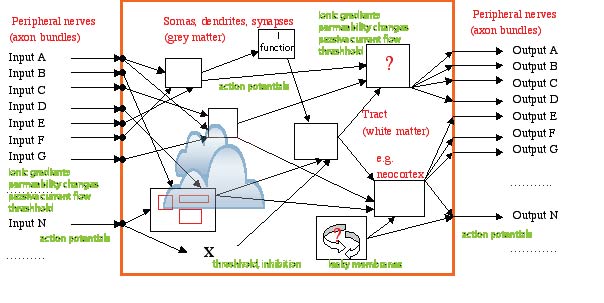
Is the brain a machine? a computer?
- "salt running in and out of channels"
- multiple interacting processors
- combined analogue and digital processing
- use dependence, no clear hardware/software or processing/memory distinction
- both local and broad band signalling
- internal autonomy, randomness
- "I-function"? itself "salt running in and out of channels" (and therefore can affect other boxes)
- functions not visible in elements that appear because of higher level architecture
Problems solved, new issues raised ...
- got inputs, outputs, boxes inside boxes
- got signals starting in middle, ending in middle
- got "I-function" as box
-
- report of internal state
- effect of external event on internal state
- action based on internal state as opposed to simply external state or "causeless"?
issues of "self", "consciousness", "free will" not avoidable - if
such terms didn't already exist, we'd have to make them up to make
sense of studies on the nervous system ... "I-function" one way into
them
-
- got general sense of how smallest boxes work
- integrators, with own contribution
- anatomical specificity, local information transmission
- pharmacological specificity, local and more global information transmission
- modified by their own activity/function
- implies all aspects of behavior/experience correspond to
patterns of action potentials in neurons (modifiable by hormones,
drugs, etc). Important "micro" base but also already some important
"macro" understandings. Behavior/experience
- involves distributed patterns of activity
- changes due to its own activity
- is sensitive to chemicals
- does not always have an external cause
- may be as much a function of inhibition as excitation
Have building blocks, some features of architecture (cables, I-function)

and some problems ...
I think Jean brings up a really interesting point about the neurons being the same yet exposed to different "bathing waters" between the two sexes. This implies that neuron activity is identical in all humans yet the difference in hormonal levels between males and females results in different interactions between neurons and their environment and consequently in different observable behavior ... Madina
After looking at Madina’s comment, I thought: “salt water running through channels”. We left class undecided on the subject of whether males and females behaved differently, but in when thinking about it, if all nervous systems are made up of “salt water running through channels,” how can human nervous systems make us act so differently from dogs? The answer lies in the receptor proteins and how every cell responds to the binding of a chemical to a receptor ... cheffernan
I would like to further discuss how the levels of such hormones are socially influenced ... Emily Alspector
despite the obvious fact that the dominant discourse back in the day discussed the female gender in terms of the male this sense of difference, and a difference that connected biological/phenotyical dimorphism with large scale social behavior/gender constructs at that, did exist. Why does this persistance for determining a difference between gender exist if there is not some basis for it? ... mcrepeau
It feels unsettling to relegate the realm of “free will” and “consciousness” to the random movement of ions and the cascade of effects neurons propagate within the brain ... Sophie F
does the I function have free will if the Nervous System is indeed an input-output machine and ordered/predictable? ... Anne.Kauth
Ok…so let’s play with this idea of behavior as a bunch of “inputs” and “ouputs” ... nasabere
Continue discussion of architecture (non-traditionally) with output - "action"(since not all outputs can be accounted for by inputs and, it will turn out, outputs can affect both inputs and the processing of them, the nervous system, like science, is "loopy")
|
Action = "motor symphony"
A new concept: the reafferent loop Accounting for motor symphony
|
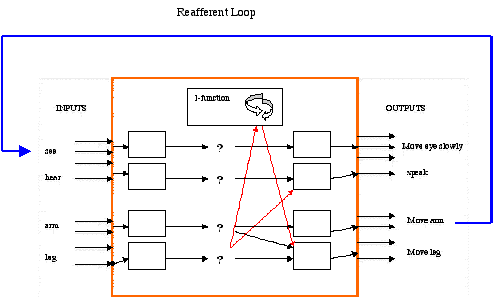
|
Reafferent loop - exteroreceptors and proprioceptors
- includes
- joint receptors
- Golgi tendon organs
- Muscle spindles - stretch "reflex"
- raises interesting issues about ns/behavior, I-function
- more looking backwards/upside down: NS generating outputs to get inputs?
- "Maybe
a leaky membrane in my mind causes me to think of neuroscience question
in class...and THEN I generate my motor output (writing down the
question), which allows me to have visual and tactile input (my written
characters themselves) ... Jackie Marano
- How many "senses"? Why traditionally 5?
- General issues to be returned to - stretch reflex relevant in re earthworm locomotion (among other things)
Preliminary human evidence?
- "central pattern generation" but ...
Looking more closely at the "central pattern generation" hypothesis
Implications of earthworm case- Reafferent patterning
- Central pattern generation?
- NS has "five ways to do same thing", proving A does not disprove B
- nervous system - more detail
- central pattern generation?
- common in lots of organisms, including humans
- may be genetic, or result of experience, usually both
- what/where are central pattern generators?
CPG as premotor circuits, interconnected neurons ("Have we resurrected the homonculus? Does this reintroduce the mind-body dichotomy?")
Motor sympony lacks a conductor - coordinated performance of independent players (cf. Boids, flocking, fireflies) - efference copy = corollary discharge
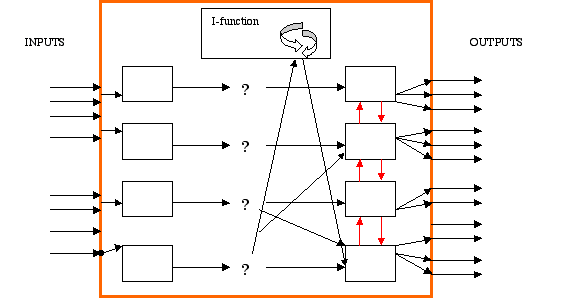
Look at some more uses/implications of corollary discharge:
- role in "perception"
- role in body sense
- phantom limb
- anosognosia
- comparison of expectation/input
- role in behavioral choice - Pleurobranchea
| Recapitulating: Where we've got to ... where we've got to go | |
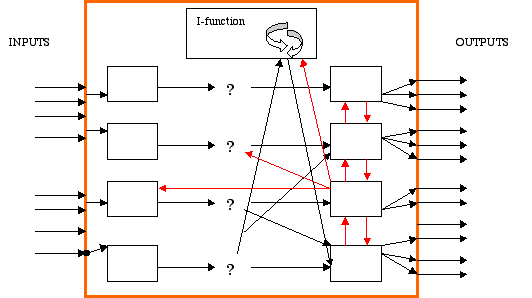 |
Can account in terms of neurons for
Have still to account for
|
I have played innumerable songs infinite times, and that I could cut off certain sensory 'inputs' (visual and/or auditory) and still play the exact song with reasonable accuracy. ... Jackie Marano
What of flightless birds? Is there any evidence of vestigial "flight" patterns indicative of an internal genetically directed score in bird species in which evolution has favored the loss of functional wings ... mcrepeau
Even some of the most common, well-practiced behaviors such as walking in humans (which might be a "centrally-stored pattern" just like flying in birds) become extremely difficult if proprioception is taken away. One particular incident comes to mind in which I attempted to stand up out of a chair and walk forward, not realizing that one of my legs had fallen asleep, and proceeded to fall flat on my face ...Caitlin Jeschke
I'm having a hard time attributing the variety of animal movement to a fully autonomous "pattern generator." Perhaps the conductor here is the environment??? Or maybe even the I-function (although it is interesting to ponder that if the CPG before the I-function is aware of it) in some instances. Some other variable must account for our ability to produce a wide range of movements ... nasabere
Certain environmental factors can of course interact with preexisting genetic components to make certain behaviors more likely ... jen benson
is the I-function conducting or just sending merely another message, say, the feedback of discontent and desire for physiological change? Indeed, this message does not always work (as I'm sure we all know), which leads me to believe that it is not a conductor. Moreover, it seems like even the I-function is subject to feedback from other stronger signals that may be saying "too bad, this is what we have to do right now." ... Simone Emily
I found the discussions last week about corollary discharges really interesting. What struck me the most intriguing was the idea that no single part of the nervous system is in charge. This is a new concept for me and will take a while to let it sink in, since I'm used to considering the brain as the "control center" of the entire nervous system but I can see its direct application in nervous system functions ... it is this particular lack of corollary discharges that allows for someone to believe that they are hearing voices ... Madina G.
an interesting article on CDs and auditory hallucinations in schizophrenic patients ... merry2e
we were asked to clap synchronously without someone directing us. I found it was intriuging that it was an everyday thing that we can do without really thinking about. Also it made me wonder what other interactions our bodies can do with one another without a "conductor" or IS there a conductor, just that we can't see it or isn't the same definition as we think it is ... ptong
Perhaps the visual input produced by "seeing" the missing limb in the mirror, thus producing input from an imaginary output, serves to reinforce the importance of the joint role of CPG's and the reafferent system, as well as the overall redundancy of the nervous system ... In this case the visual "input" is able to mimic part of the reafferent loop and compensates for the discrepancies in the corollary discharge networks by producing a "direct" input that "reports" on the missing limb ... mcrepeau
Does this, however, account for messages that we send ourselves, so-called “self-talk?” For example, someone with an eating disorder, who may be visibly emaciated to outside observers, but “believes” herself and may even “see” herself as being overweight ... Sophie F
What is interesting is how [corollary discharge] relates to I-function and the mind (or spirit, soul, what have you). Is this feedback system all that accounts for our mind? It seems unlikely, but plausible. Also, there is a similar disorder known as somatoparaphrenia where the patient rejects ownership of a body part; it would be interesting to see where corollary discharge plays a role in such cases ... Emily Alspector
In class we decided that no one part of the nervous system is “in charge,” but rather, all the different boxes communicate with each other via corollary discharge signals. I suppose having a central control box that signals were sent to would add another step and decrease efficiency, but I wonder what we consider the I-function? Have we not been describing it as some sort of control module? ... Skye Harmony
f we are to accept that some patterns of behavior are innately programmed into our nervous systems, then I think that we must at the same time take up the question as to whether life truly is "nasty, brutish and short." If we'd like to conclude otherwise, I think we'd better start searching for biological justification of an I-function pretty soon, because without it I don't see much hope for any argument to the contrary ... Molly Pieri
I am also a little confused about the I-function. It may sound weird but even as a write this post the words are going through my mind before I am able to type them out on my laptop. I always considered this voice inside my head as my I-function. But I now find myself perplexed, if the I-function is interpreting signals or 'inputs', then isn't it just another 'box' hardwired into the human body, am I attributing the voice in my head to the I-function even though it should not be? ... llamprou
Perhaps there are other mechanisms in play that can inhibit, control, or modify hard-wired tendencies? ... maggie_simon
ook at some more uses/implications of corollary discharge:
- role in "perception"
- role in body sense
- phantom limb
- anosognosia
- comparison of expectation/input
- role in behavioral choice - Pleurobranchea
Output affects input ... input affects output?
Let's reinstate reafferent loop, see what new things that gets us
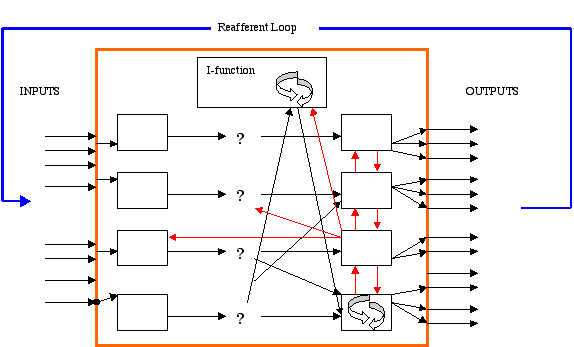
Stretch "reflex"
Not an input-output pathway but a feedback loop- input causes output; output causes input - no "simple" cause/effect
- negative feedback - stabilizing, "purpose"?
- thermostat - variable setpoint
- temperature regulation
- weight control
- others?
Getting it less wrong - comparison of what one expects from an action with the results and updating
| Linear science | Seriously loopy science |
 |
|

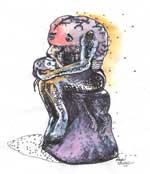


Comments
.
Post new comment